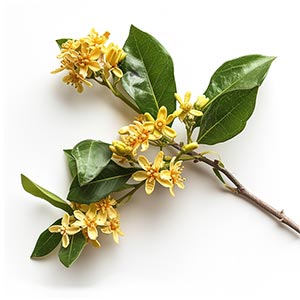Osmanthus, derived from the fragrant flowers of the Osmanthus fragrans plant, is a prized ingredient in perfumery known for its delicate and apricot-like aroma. With a history deeply rooted in traditional Asian cultures and a contemporary presence in the world of modern fragrances, Osmanthus adds a touch of floral elegance and fruity sweetness. The use of Osmanthus in perfumery can be traced back to ancient China, where it held symbolic significance in traditional ceremonies and was admired for its captivating fragrance. In Chinese folklore, Osmanthus is associated with romance and love. Today, it is cultivated in various regions, including the Mediterranean, to harness its exquisite scent for perfumery. Osmanthus contributes to fragrances with its unique combination of floral and fruity notes. The blossoms are often used to create intricate floral accords, and the hint of apricot adds a sweet and inviting facet. Its versatility allows perfumers to incorporate Osmanthus into a variety of compositions, from light and airy scents to more complex and opulent fragrances. Embrace the enchanting allure of Osmanthus in fragrances, where its delicate floral and fruity tones transport you to a blooming garden in full splendor.
Natural or Synthetic?
Osmanthus fragrans flowers are solvent extracted to produce an absolute, known for its rich, sweet, fruity floral fragrance with leather and green nuances. Due to the high cost and limited availability of the natural oil, synthetic versions are also used. These synthetics attempt to replicate the natural scent's complexity, involving various aroma chemicals to mimic its fruity, floral, and green characteristics.
Fragrance Families Osmanthus Most Commonly Found In
Show fragrances that contain Osmanthus as a note



